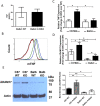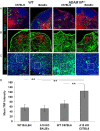Increased B Cell ADAM10 in Allergic Patients and Th2 Prone Mice
- PMID: 25933166
- PMCID: PMC4416757
- DOI: 10.1371/journal.pone.0124331
Increased B Cell ADAM10 in Allergic Patients and Th2 Prone Mice
Abstract
ADAM10, as the sheddase of the low affinity IgE receptor (CD23), promotes IgE production and thus is a unique target for attenuating allergic disease. Herein, we describe that B cell levels of ADAM10, specifically, are increased in allergic patients and Th2 prone WT mouse strains (Balb/c and A/J). While T cell help augments ADAM10 expression, Balb WT B cells exhibit increased ADAM10 in the naïve state and even more dramatically increased ADAM10 after anti-CD40/IL4 stimulation compared C57 (Th1 prone) WT B cells. Furthermore, ADAM17 and TNF are reduced in allergic patients and Th2 prone mouse strains (Balb/c and A/J) compared to Th1 prone controls. To further understand this regulation, ADAM17 and TNF were studied in C57Bl/6 and Balb/c mice deficient in ADAM10. C57-ADAM10B-/- were more adept at increasing ADAM17 levels and thus TNF cleavage resulting in excess follicular TNF levels and abnormal secondary lymphoid tissue architecture not noted in Balb-ADAM10B-/-. Moreover, the level of B cell ADAM10 as well as Th context is critical for determining IgE production potential. Using a murine house dust mite airway hypersensitivity model, we describe that high B cell ADAM10 level in a Th2 context (Balb/c WT) is optimal for disease induction including bronchoconstriction, goblet cell metaplasia, mucus, inflammatory cellular infiltration, and IgE production. Balb/c mice deficient in B cell ADAM10 have attenuated lung and airway symptoms compared to Balb WT and are actually most similar to C57 WT (Th1 prone). C57-ADAM10B-/- have even further reduced symptomology. Taken together, it is critical to consider both innate B cell levels of ADAM10 and ADAM17 as well as Th context when determining host susceptibility to allergic disease. High B cell ADAM10 and low ADAM17 levels would help diagnostically in predicting Th2 disease susceptibility; and, we provide support for the use ADAM10 inhibitors in treating Th2 disease.
Conflict of interest statement
Figures






Similar articles
-
Disturbed follicular architecture in B cell A disintegrin and metalloproteinase (ADAM)10 knockouts is mediated by compensatory increases in ADAM17 and TNF-α shedding.J Immunol. 2013 Dec 15;191(12):5951-8. doi: 10.4049/jimmunol.1302042. Epub 2013 Nov 13. J Immunol. 2013. PMID: 24227779 Free PMC article.
-
ADAM10 and Notch1 on murine dendritic cells control the development of type 2 immunity and IgE production.Allergy. 2018 Jan;73(1):125-136. doi: 10.1111/all.13261. Epub 2017 Aug 31. Allergy. 2018. PMID: 28745029 Free PMC article.
-
Adrenergic regulation of IgE involves modulation of CD23 and ADAM10 expression on exosomes.J Immunol. 2013 Dec 1;191(11):5383-97. doi: 10.4049/jimmunol.1301019. Epub 2013 Oct 18. J Immunol. 2013. PMID: 24140643 Free PMC article.
-
The good, the bad and the ugly substrates for ADAM10 and ADAM17 in brain pathology, inflammation and cancer.Semin Cell Dev Biol. 2009 Apr;20(2):164-74. doi: 10.1016/j.semcdb.2008.09.005. Epub 2008 Sep 18. Semin Cell Dev Biol. 2009. PMID: 18951988 Review.
-
The Gut-Brain Axis in Autism Spectrum Disorder: A Focus on the Metalloproteases ADAM10 and ADAM17.Int J Mol Sci. 2020 Dec 24;22(1):118. doi: 10.3390/ijms22010118. Int J Mol Sci. 2020. PMID: 33374371 Free PMC article. Review.
Cited by
-
ADAM10-Mediated ICOS Ligand Shedding on B Cells Is Necessary for Proper T Cell ICOS Regulation and T Follicular Helper Responses.J Immunol. 2017 Oct 1;199(7):2305-2315. doi: 10.4049/jimmunol.1700833. Epub 2017 Aug 16. J Immunol. 2017. PMID: 28814605 Free PMC article.
-
Pathology of female mice experimentally infected with an in vitro cultured strain of Trypanosoma equiperdum.J Vet Med Sci. 2021 Aug 6;83(8):1212-1218. doi: 10.1292/jvms.21-0056. Epub 2021 Jun 16. J Vet Med Sci. 2021. PMID: 34135196 Free PMC article.
-
Allergen-dependent oxidant formation requires purinoceptor activation of ADAM 10 and prothrombin.J Allergy Clin Immunol. 2017 Jun;139(6):2023-2026.e9. doi: 10.1016/j.jaci.2016.12.954. Epub 2017 Jan 19. J Allergy Clin Immunol. 2017. PMID: 28111309 Free PMC article. No abstract available.
-
Cellular and Molecular Events in the Airway Epithelium Defining the Interaction Between House Dust Mite Group 1 Allergens and Innate Defences.Int J Mol Sci. 2018 Nov 10;19(11):3549. doi: 10.3390/ijms19113549. Int J Mol Sci. 2018. PMID: 30423826 Free PMC article. Review.
-
Targeting ADAM17 to dampen dendritic cell-mediated type 2 immune responses and airway inflammation associated with allergic asthma.Sci Rep. 2025 Aug 25;15(1):31253. doi: 10.1038/s41598-025-14569-w. Sci Rep. 2025. PMID: 40854915 Free PMC article.
References
-
- Le Gall SM, Bobe P, Reiss K, Horiuchi K, Niu XD, Lundell D, et al. ADAMs 10 and 17 represent differentially regulated components of a general shedding machinery for membrane proteins such as transforming growth factor alpha, L-selectin, and tumor necrosis factor alpha. Mol Biol Cell. 2009; 20: 1785–1794. 10.1091/mbc.E08-11-1135 - DOI - PMC - PubMed
-
- Conrad DH, Ford JW, Sturgill JL, Gibb DR. CD23: an overlooked regulator of allergic disease. Curr Allergy Asthma Rep. 2007; 7: 331–337. - PubMed
-
- Weskamp G, Ford JW, Sturgill J, Martin S, Docherty AJ, Swendeman S, et al. ADAM10 is a principal 'sheddase' of the low-affinity immunoglobulin E receptor CD23. Nat Immunol 2007; 7: 1293–1298. - PubMed
-
- Di LG, Drago A, Pellitteri ME, Candore G, Colombo A, Potestio M, et al. Serum levels of soluble CD23 in patients with asthma or rhinitis monosensitive to Parietaria. Its relation to total serum IgE levels and eosinophil cationic protein during and out of the pollen season. Allergy Asthma Proc. 1999; 20: 119–125. - PubMed
Publication types
MeSH terms
Substances
Grants and funding
LinkOut - more resources
Full Text Sources
Other Literature Sources
Medical
Molecular Biology Databases
Research Materials
Miscellaneous

